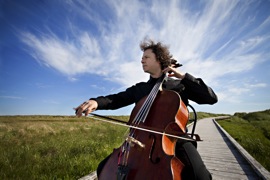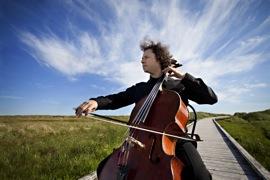
Matt Haimovitz is finishing off a landmark birthday year, and so is his instrument. The Montreal-based cellist, celebrated for his spirited approach to genre-bending and performance, is a mere 40. But his cello, made by Venetian luthier Matteo Goffriller, has turned 300. This year, the birthday pair, in company with a “big band” of seven other cellos and cellists (in the ensemble Uccello), recorded a fascinating classical take on jazz material, titled Meeting of the Spirits (on Haimovitz’s Oxingale label). The National Academy of Recording Arts and Sciences, in return, nominated Haimovitz and Uccello for a 2011 Grammy for Best Classical Crossover Album. A week after the Dec. 1 announcement, Haimovitz lodged his family at the Cavallo Point Hotel at Fort Baker, outside Sausalito, from which he traveled to several appearances around the Bay Area, where he’d spent his youth. Over tea at the hotel, he talked with SFCV about his visit, the Grammy-worthy album, and his wide-ranging musical mission.
What are you doing here, besides relaxing in these former officers’ quarters?
I’m part of a benefit gala for the Pacific Musical Society. They supported me when I was living here, with scholarships, and it’s nice, three decades later, to come back. I’ll play some Bach and also join some other performers, Jake Heggie and Frederica Von Stade, and Lisa Delan, and a couple of others. We’ll do one of Jake’s pieces, which we recorded, for soprano, cello, and piano. And we’ll do one of Gordon Getty’s pieces that Luna [Luna Pearl Woolf, Haimovitz’s composing and producing wife] arranged. We’ve gotten to know Mr. Getty quite well. I’ll also do a master class at the [San Francisco] Conservatory, which I’m really looking forward to, and an in-store at Amoeba [the record store]. I’m gonna play from Matteo: 300 Years of an Italian Cello [his latest album, a symbolic gift to his instrument], which juxtaposes the Domenico Gabrielli ricercar with more modern works. And then I’ll take a little time off. We are being joined by grandparents; we’re going to Monterey, avoiding the snow for another week or two. I was dying to go to Venice, but Luna and I have an eight-month-old, Maia, and I couldn’t quite make it.
How did you feel when you heard about the Grammy nomination? Where were you?
I was at home, in Montreal, where I’m teaching [at the Schulich School of Music at McGill University]. I was falling asleep, but I had remembered that the telecast was happening. It was about one in the morning, and I decided to check the Grammy Web site. I just kept scrolling down to the third-to-last category, and saw “Meeting of the Spirits,” and I thought, I must be dreaming. And then of course I saw our competition — Bobby McFerrin, Jessye Norman, and some others. And I think I yelled pretty loudly from my bedroom. Luna was actually in the other room with the baby, and I ran in to show her the screen. And we did a little dance. [Chuckles]
A freilach [Jewish celebratory dance] would have fit. Did the nomination seem fitting?
My life has been surreal for many years. It’s my first real Grammy nomination, and it’s on a jazz CD, with my students [i.e., the members of Uccello]. I’ve spent the last 30 years playing contemporary classical and standard classical, and this [crossover] is what got the nomination, but I’m thrilled.
How far back does jazz go for you?
That’s a good question, because I come from a very sheltered upbringing. Classical was “it” — that’s all I knew. It was a Central European sort of home. Mother was a pianist, and we went to many piano concerts while we were living in the Bay Area, in Palo Alto. She was a piano teacher; at that time, her name was Marlena Haimovitz. This was in the late ’70s, early ’80s. We’d moved from Israel; my father was an engineer in Silicon Valley. That’s what I grew up with. My first year of college, at Princeton, I met Steven Mackey, composer and electric guitar player. And I was fascinated by the idea of improvisation. I had never done any of it, and he just sat me down and for the entire year I didn’t go to many classes, I just chatted with him and improvised. And he’d take out LPs of Jimi Hendrix, Janis Joplin, Miles Davis, John Coltrane; it was the first time I’d heard [them]. And from there I became pretty voracious about it.
For me, with jazz, the fascination over the years has been with improvisation, and the idea that in the classical tradition, we had it for so long, with Bach, Beethoven, Mozart, through to Bartók. And then something happened: Composers stopped trusting performers, and they started notating everything. I just played a program of Italian cello music and played this Gabrielli ricercare, a precursor of Bach. [Gabrielli] was a cellist himself, and basically, he just wrote down these improvisations; they’re very fantastical; he would just jam on his own and write it down.
Tell me a bit about the specifics of Meeting of the Spirits. I gather that one of my jazz favorites, Ornette Coleman, is in there.
That arrangement [by David Sanford] is based on a John Zorn version of an Ornette Coleman tune, “W.R.U.” David was thinking about the energy and sound that John Zorn brought to it. And I think it was brilliant that David chose [Miles Davis’] “Half Nelson,” done in the Gil Evans style of multivoice arrangement. That’s perfect for a cello choir. And other ones, like John McLaughlin’s “Open Country Joy,” where each one of us takes on a different role. It works on the cello, because you can make it sound like an electric guitar, a bass, and a keyboard. [Guitarist McLaughlin, drummer Matt Wilson, and keyboardist Jan Jarczyk guest perform on some tracks.]
You’ve said that improvisation is returning to classical performance. Are young composers getting turned on to jazz and rock?
I think it’s partly that. The strict serial approach hit a wall with audiences, in terms of what people can take, though I happen to love that tradition. And minimalism, the same thing — “it’s been done.” Now, with all these different threads, I think composers are just more open to using them as tools, and there’s more perspective on what’s happened.
Is improvisation a part of your compositional and arranging process?
I wouldn’t do it in a Bach cello suite. But every year I kind of take on something, and I’ve done a pretty extensive improvisational project with DJ Olive [the turntablist born Gregor Asch]. What I love about working with him is, he’s got an unbelievable ear; it’s like doing chamber music. Even though he comes from a totally different genre and musical background, the way he listens is so responsive. What’s amazing to me is that he can actually do things at pitch, so if I’m in a certain key, he’ll scratch in tune to me.
There’s a lot of talk about the graying of the audience (present company included, though I don’t feel gray). And presenters and composers, maybe performers too, have thought, We don’t want just older folks coming in and listening to Beethoven and Brahms, we gotta have a gimmick!
Certainly I’ve made an effort to reach out to a broader audience. Since 2000, I started playing rock ’n’ roll clubs and jazz clubs: CBGB in New York, here in Berkeley the Freight & Salvage, in Los Angeles The Mint.
What’s the “hit” for you in doing a place like the Freight?
Well, the informality of it. I can talk to the audience, talk from the stage. At a venue like that, you’re expected to entertain.
What do you talk about?
Sometimes it would just be what I did that day, how I got there, and they could connect with me as a human being. Other times, it’s my own personal feelings about the pieces. I had a theory about the second [Bach cello] suite. The second minuet is kind of a lullaby for me, and the idea that Bach lost an infant child the year before he wrote these pieces [ca. 1720], and lost his first wife also in that time frame, I imagined that this was a bit of a memorial for that sense of loss. And certainly the suite is in a minor key, filled with pathos.
It seems vital to you to always risk and search a bit.
And a lot of it has to do with New Music — and some “old” music. I didn’t really know the Gabrielli ricercare until I started digging up the music before Bach. In 2003, after 9/11, I wanted to celebrate American music [with a tour and album under the title Anthem]. But then I started feeling ambivalent about the response of the [American] administration, and I made an arrangement of Jimi Hendrix’s Star-Spangled Banner for solo cello, and I would close out each show with that. There were two works that were responses to 9/11 that I commissioned: one by David Sanford, Seventh Avenue Kaddish, and one by Tony Twining (a microtonal composer), 9:11 Blues, using the 9th and 11th overtones in the series to create a sense of blues. But this music ranged from Osvaldo Golijov to Steve Mackey to a whole range of things.
I definitely felt like I was participating in the political process, to some extent, because the election was taking place, in 2004, and with everything going on around the world, it felt like that project was tied to the politics of the time. And there was this whole idea of freedom of expression, after feeling a sense of intimidation, in the Bush administration, where anyone who spoke up against the Iraq War was not patriotic. It was feeling that music could be a powerful force, and how important a part of the culture these composers are, really. Just bring them in to the heart of the battle.

